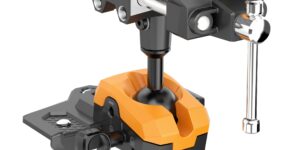MULTI-TASKING: REVOLUTION IN THE EVOLUTION
Variable, high-speed spindles enhance multi-tasking flexibility in CNC machining.
Posted: November 13, 2008
When CNC automation replaced numerical control systems they effectively reduced the time required to changeover the machine to produce different components, and they provided CNC operators with the flexibility and time to perform additional tasks.
Few would disagree that the introduction of CNC machines radically changed the manufacturing industry ? curves became as easy to cut as straight lines, complex 3D structures became relatively easy to produce, and the number of machining steps that required human actions dramatically reduced.
Now, machine tool automation is making another evolutionary jump into multi-tasking. Machine tool multi-tasking originated 25 years ago, but as of late it has become quite the mantra with machine tool developers, and for good reason ? such systems can show substantial improvements in yield, in some circumstances up to a 400 percent increases in productivity. Machine tool manufacturers are feeding this movement by continuing to expand their offerings of machine tools with multi-tasking functionality.
Although machine tool multi-tasking typically refers to processes that normally would require multiple machines ? such as turning, milling, drilling, taping, boring and finishing a part ? it can also delineate variable, high-speed spindles that can perform multi-tasked functions within a CNC. The latter is less well known because of its recent introduction into the CNC multi-tasking environment, but is rapidly gaining acceptance as a versatile combined high-speed/low-speed spindle alternative to the dedicated high-speed and low-speed traditional tools.
Many high-speed CNC machines do not have the torque for low-speed work, and machines with lower spindle speeds cannot perform high-speed work. When interfaced with a machine's existing controls, these VRT variable, high-speed, multi-tasked spindles can be used like any other tool in the machine's tool changer, completely unattended. There is no need to use a separate spindle for each speed to be run.
The spindle has a variable speed, i.e. from 15,000 to 40,000 rpm. This enables machines with lower spindle speeds to now also perform high-speed work, and high-speed machines to perform low-speed work, using the same spindle. The speed is externally adjustable and self-regulating. Multi-tasking machines loaded with these spindles offer a great deal of production potential, as they can often completely machine a part on its own.
MULTIPLE OPTIONS FOR MULTIPLE TASKS
More Than One Way: Multi-tasking typically refers to turning, milling, drilling, taping, boring and finishing a part that normally would require multiple machines. But it also describes variable, high-speed spindles that perform multi-tasked functions within a CNC. These are rapidly gaining acceptance as versatile combined high-speed/low-speed spindle alternatives to the dedicated high-speed and low-speed traditional tools.
These variable, high-speed spindles reduce part costs because fewer spindles are needed. Labor is reduced because multiple setups requiring additional handling are eliminated. One tool can be applied to a wider range of applications, allowing for minimal inventory and machines themselves, to be held by the manufacturer.
The higher degree of versatility enables one spindle to machine a various range of materials. They therefore provide a more cost effective alternative to dedicated high-speed and low-speed spindle machines.
One manufacturer that is at the forefront of variable, high-speed spindle design is Bryan Machine Service, Inc., which just last year introduced a line of multi-tasked high-speed spindles for CNC machining. Originally designed for a Haas VMC, these VRT spindles operate on a compressed air turbine with an internal regulator that works to maintain the same speed in varying loads.
The regulator is operator adjustable from the 15,000 to 40,000 rpm range. When used in a CNC machine with its ACH125c autocoupler, it can outperform any tool in the CNC machine's tool changer for unattended operation. The machine tool will pick up the spindle out of the tool changer, like any other tool, then the coupler engages the air supply to it. Along with the existing machine-controlled auto coupler, this spindle can be used like any other tool in the machine's tool changer.
The spindle is adaptable to most existing CNC machines, including lathes. For grinders, the coupler can be adapted to virtually any machine. It uses standard 11ER collets. When not in use, both sides of the autocoupler are closed to prevent coolant and debris from entering. When interfaced to the CNC control, a simple command engages the autocoupler and starts or stops the VRT. The VRT-NT model does not require tools to make speed adjustments. The pushing of a button and turning the spindle will increase or decrease the speed.
"If there is a very low spindle rpm on a machine, you can add the VRT variable, high-speed spindle and quadruple the rpm capability of the machine," says Jeff Holtzapple of the Haas Factory Outlet in Fort Wayne, IN. "A normal spindle will be limited to whatever that machine's motor can generate. By varying the speed of the spindle the operator can optimize the cutting of the tool. If I have two tools made of different materials, one softer than the other, I may have to run the softer material at 15,000 rpm and the harder material at 40,000 rpm, I have that capability of changing the rpm with this spindle. The operator can optimize the tool speed for whatever he is doing.
"This spindle is located inside the existing machine spindle, uses air to generate increased rpm, and uses the machine motion to make the cut," explains Holtzapple. "Very different from the typical spindle or other 'speeder heads' because it provides a variable-rpm capability. It also allows the flexibility of interchangeability between the machine's original spindle and the VRT variable spindle for tool changes as needed, like with any other tool in the machine's carousel."
As the multi-tasking evolution in machine tools progresses, new machine component devices, such as variable, high-speed spindles, will continue to augment the forward motion spearheaded by the CNC machine tool manufacturers.
High-efficiency machining with optimized cost of operation and return on investment is the goal, a necessary objective for any manufacturer desiring to remain profitable in today's highly competitive machine tooling environment.
– – – – – – – – – – – – – – – – – – – – – – – – – – – – – – – – – – – – – – – – –
Author Jim McMahon writes on industrial technology.
Bryan Machine Service, Inc., 345 Commerce Drive, Huntington, IN 46750, 260-356-5530, Fax: 260-356-5234, www.bryanmachine.com.









